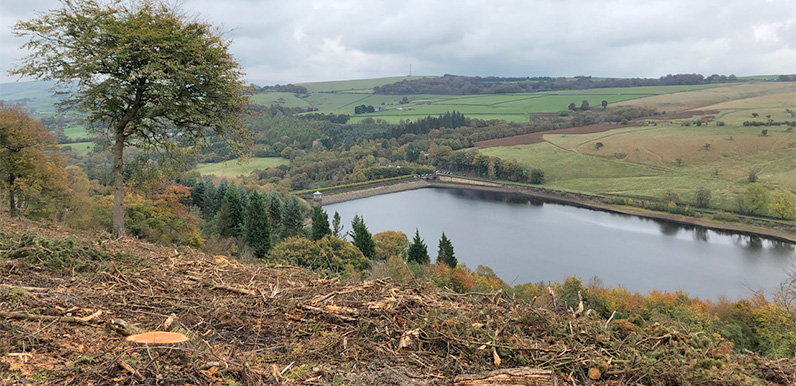Above: New vistas above Fernilee! I’m just hoping they’ll let the native broadleaf trees take over – as nature intended.
I walked the wide track above Fernilee last weekend for the first time since the tree-felling began back in August. And what a transformation it’s made to the views across the reservoir. I think it’s the best thing that’s happened in the valley for a very long time.
I assumed the trees were being felled as part of a regular programme of planting and harvesting. So I thought the views being opened would soon be obscured by yet more fir trees. But it seems I was wrong.
Alex is a professional tree surgeon and a member of the Goyt Valley Facebook group. He explained that the trees were being felled because of phytofra:
Phytofra effects fir trees and is the reason they are all being felled before it takes over the woodland. it’s in the ground and can travel as long as it has trees to feed on along the way.
However if there are no trees to feed off it’ll stay contained in one area and eventually die off. It doesn’t effect broad leaf trees, hence why they’ll be planting a new forest with no firs.
Above: a slideshow of images taken on 18th October 2020.
Alex also explained why Forestry England are doing the felling now:
It’s being done now while the timber’s sound, otherwise it would of been a lot more years till they were harvested. It will be nice to see broadleaf trees. And as much as I’m in the industry, and understand the need for it, it’ll nice to see that area not used for forestry.
I’ve asked Alex if he knows what plans the FE has for replanting. I’m hoping they’ll let the landscape recover and evolve, allowing the native broadleaf trees to flourish. I’ve also asked if the FE will be extending the tree-felling closer to Goytsclough and Errwood. I’ll update this page when I hear back.
All of the Pine have been felled as part of Forestry England’s regular programme. Unfortunately some areas of Larch were found to have Phytophthora ramorum. Forestry England made the decision to fell the Larch in the areas the harvesting contractors are working while they are working on site before the infection has chance to spread further. Infected trees produce a large number of spores, and air currents can spread these spores a number of miles. You can expect that there will be further forestry operations in and around the Goyt Valley to remove the remaining Larch trees.


Greetings, I’m a motorcyclist who regularly rides the ‘green lanes’ of the area. My colleagues and I are fascinated by the industrial archaeology, history and information. Thank you for this site and the valuable information that it provides.